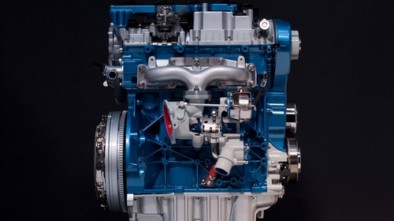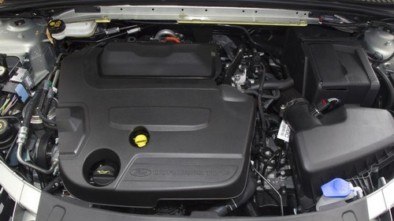Ford Mondeo 3 2000 - 2007 - used, experience, malfunctions
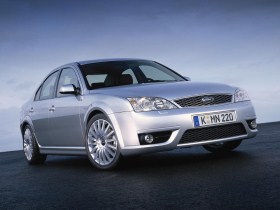
Ford Mondeo 3
The third-generation Ford Mondeo appeared on the market in 2000. Like the previous generation, it is available in sedan, sedan and station wagon variants. The Ford Mondeo had two restylings, the first in 2003 and the second in 2005. Its biggest advantages over the competition in the middle class - price, equipment offered and modern design.
The mid-range sedans are an incredibly interesting segment that uniquely associates everyone with the Passat. However, in addition to the German sedan in the used car market, there are several other interesting models that, given the height of the price, go beyond Volkswagen. One of them is the Ford Mondeo 3.
Compared to its predecessors, the Ford Mondeo 1, and the Ford Mondeo 2, this Ford model is a huge step forward. This can be seen with the naked eye. For the first time in this segment, the American manufacturer is running out of style. Comparing this car to the oval-shaped Ford Mondeo 2, you will immediately notice the sharper edges and slightly more dynamic yet elegant design of this model.
The Ford Mondeo 3 has gained a lot in its attractiveness over its predecessor. Not just styling, but also technical.
Ford Mondeo also offered a wealth of equipment, without which it would be difficult to compete in this segment. Interestingly, however, the Ford Mondeo is one of the best-equipped cars in this price range. If we can find a good specimen it can be found with electronic lifts, automatic air conditioning, trip computer, glass warming, electrical adjustment and seat heating, leather upholstery and even xenon headlights, which came in later models.
Almost everything is designed from scratch. The body was given an interesting shape of sharp chassis lines. Traction reached its highest level without compromising comfort. Three body versions are offered, with varying degrees of functionality. The engine range offers new designs, including modern high-power turbo diesel engines, in terms of work culture they consider it one of the best.
The Ford Mondeo, produced since 2000, is a completely modern car - a comfortable, spacious trunk in a sedan and hatchback variants has a capacity of 500 liters, a station wagon up to 540 liters. Especially with the introduction of the new Ford Mondeo, the reliability of cars and engines has been raised, offering extended conditions so that cars do not fall on average. For those looking for a modern mid-range car, it can be a good choice after all.
The Ford Mondeo ST200, produced from 2002 to 2006, the most powerful Ford Mondeo ever produced, has a 6-liter V3.0 engine developing 223 horsepower at 6250 rpm. Acceleration from 0-100 km / h in 7,7 seconds and a top speed of 243 km / h.
Ford Mondeo - a spacious and comfortable car, also fun to drive. While diesel engines are a big improvement over those in the old model, since the introduction of TDCi engines in November 2001 when they really became competitive. The first major change in the Mondeo came in the summer of 2003 with improved quality and a higher level of equipment available, while it underwent further revisions in 2005.
The third-generation Ford Mondeo is a very interesting proposition for those interested in buying a spacious, family car. It costs less than the German competition, and is often closer to sedans from France. The market is supplied with wholesale models, there is no shortage of cars with rich Ghia equipment.
COMFORT - Ford Mondeo 3
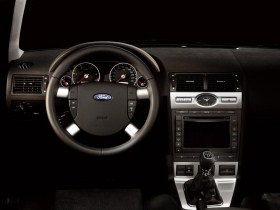
Ford Mondeo 3
The interior of the new Monde is much ahead of the previous generation. All changes are dictated by the need to remain competitors. So, they are equipped with, among other things, satellite navigation, Sony audio system, automatic air conditioning, electrically adjustable seats, mirror and windows.
The trunk Ford The Mondeo is highly praised with its 500 liter sedan and sedan version. The caravan, which, as well as the focus, is equipped with a rear lamp mounted on a pedestal, which is characterized by 540 liters of luggage space, a volume that can be increased to 1700 liters by folding the rear seats.
Interior quality is generally good, although it was further improved in the summer of 2003.
What sets the Ford Mondeo apart from other competitors in the class is the driving pleasure it provides. Is this a sedan, it is nice and big, but this size hides perfectly in driving with excellent steering response and great lying on the road as well as easy controls. The only thing that spoils the whole impression is the wind noise at higher speeds.
As far as driving position is concerned, the steering wheel is adjustable in height and depth, the seat is also adjustable in height, so drivers of all sizes will be comfortable. There is plenty of space at the back so you can carry five people without any hassle. The trunk is very spacious and the rear bench folds on all models. The quality of the workmanship itself is excellent, so you can expect this half to serve you for a long time.
All models of the third generation Ford Mondeo come with four power windows and air conditioning as standard. The interior is spacious (passengers have as much space as in the old Ford Scorpio) and the seats are comfortable. Engine noise can be a problem on the first 2.0 TD models, although TDCi diesel engines are much better, while sportier models with larger wheels can carry a fair amount of road noise through the cabin. Since summer 2003, top models have been available with front seat heating and ventilation and rear seat heating.
Once again, Ford put the emphasis on safety. It was especially important in the construction of vehicles. The new IPS, based on reading from sensors spread throughout the car, decides when to use driver, passenger, head, and side airbags as appropriate. Of course, to face competition in terms of safety, the Ford Mondeo is also equipped with ESP and ABS.
Unfortunately, the solutions used by Ford Mondeo were not enough to perform better than their opponents in the Euro NCAP test. D-segment of the vehicle Opel, Volkswagen, Toyota i Citroen score much better. Despite the revision, the Ford Mondeo still did not sufficiently protect the driver's chest in the event of a collision, it was higher than the average likelihood of damage.
ENGINE - Ford Mondeo 3
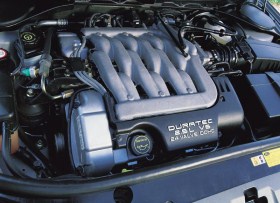
Ford Mondeo 3 engine
The specific third-generation Ford Mondeo engines, just like in the previous generation of the Ford family, guarantee a wide range of possibilities. For those who are looking for economical solutions, diesel engines are primarily intended. The 1,8-liter diesel has been replaced by a modern, 16-valve, 2-liter TDCi engine with variable turbine blade geometry, available in three variants: 90 hp, 116 hp and 131 hp. It even has one diesel unit 2.2 - liter Duratork engine with 155 hp.
Gasoline engines - the weakest of them has 110 horsepower Duratec 1,8 liter next two engines of the same size grow 125 and 131 hp. If that wasn't enough, Ford also offered a 2-liter, in-line, 143 horsepower. 2,5 liters, develops 170 hp and 220 Nm of torque. For the hungry are in charge, the V6 with a capacity of 3 liters delivers a basic variant of 205 hp, the most powerful of 226 hp is available in the Ford Mondeo ST220 - equipped with a diverse sports styling package, better suspension and better brakes.
The most popular Ford Mondeo is the diesel or 1.8-liter petrol models. Although the 2.0 turbo diesel model was a huge improvement over the 1.8 TD in the previous Mondeo, it still lost to similar engines from Peugeot, Citroen, Renault and Volkswagen in terms of efficiency and sophistication. In late 2001, Ford offered a 2.0 TDCI engine that adopted the latest diesel technologies. It produces 130 hp and offers a great combination of performance, fuel economy and sophistication. The original 115 hp 2.0 TD ran until 2002, before it was replaced by the 115 hp version 2.0 TDCi which is a far superior engine. In 2004, the high-performance 2,2-liter TDCi was introduced with 155 hp. In August 2005, Ford launched the 90 hp version of the 2.0 TDCi, which aims for the company’s driver, who while not having the power compared to the 115 hp diesel, doesn’t feel much slower on the road. The 1.8-liter petrol engine is decent for a car, although the 2,0-liter feels much livelier with slightly higher fuel consumption. During 2003, Ford launched a direct-injection petrol engine called the 1.8 SCI, which promised better fuel economy in everyday driving compared to a conventional petrol engine, but also improved performance and is livelier than the standard 1,8-liter, also sounds sporty when accelerating . The SCi engine is only available in the Ghia, Titanium and Ghia X models. The fastest Ford Mondeo is the ST220, which has a 226 hp 3.0-liter V6. A less powerful version of this 3,0-liter engine is available in the luxury version of the Ford Mondeo, as well as a more sedan 170 hp 2.5-liter V6. The Ford Mondeo is equipped with a five-speed manual transmission as standard when it launched (a version of the six-speed manual became an option later), but newer cars will have a six-speed transmission as standard.
Recommended engine versions: Petrol 2.0 One of the most common engines provides a reasonable compromise between dynamics and flexibility and combustion. Buying a two-liter Mondeo is usually a smaller burden on the budget than buying a Ford Mondeo with a diesel engine. For driving mostly short distances, the operating costs are comparable. The petrol engine consumes larger amounts of fuel, but the cost of repairing the diesel is significantly higher.
2.0 TDDi: Practice shows that the less complicated the engine design, the less likely it is to fail. The theory works for the Ford Mondeo. Less complicated diesel gives a mediocre effect, however, it turned out to be more durable. The problem with the 2.0 TDCi engine is the fuel injection system - metal shavings from consuming a high pressure pump clogged injector. Of course, replacing only the injector is practically meaningless. For the repair to be effective, you must purchase a new pump.
Ford engines have not been designed to run gas installation since 2000. The materials used in the construction of the engine heads prevent the long-term functional supply of LPG, as the automaker does not recommend the installation of gas. Driving a Ford Mondeo on gas can end up with major engine repairs, even after low mileage.
Ford Mondeo - Model History:
autumn, 2000 - model premiere (sedan, hatchback, station wagon), 1.8 16V engine (110 or 125 hp), 2.0 16V (145 hp), 2.5 V6 24V (170 hp), 2.0 16V DI (diesel, direct injection, 90 or 115 hp).
July, 2001 - end of production version 2.0 16V DI.
August, 2001. - 2.0 16V TDCi (turbo common rail 115 hp).
November, 2001 - 2.0 16V TDCi (turbo common rail 130 hp).
April, 2002 - sport version ST 220 3.0 V6 24V engine (226 hp).
June, 2003 - modernization: new front end - styling and headlights, rear lights and new exterior mirrors, interior changes.
September, 2003 - 1.8 16V SCi engine (direct petrol injection, 130 hp).
2005 - 3.0 V6 engine (204 hp) and 2.2 16V TDCi (turbo common rail 155 hp).
FAULTS - Ford Mondeo 3
Ford is not very popular as a reliable manufacturer, but lately, people at this factory have been seriously trying to change their reputation. With this model, they came in handy. Check the running engine as there were problems with the injectors on the TDCi turbo diesel, as well as the suspension that is on all Ford models. There are some failures that we can point to in all models, so maybe check out all the electronics, since this is the most common thing that goes with all this car. Gearboxes and motors are great, just avoid them if you come across an automatic.
When buying a used Ford Mondeo 3 you should pay attention to the exhaust at about 100 km can corrode. TDCi engines sometimes have problems with the turbocharger. Also, note the condition of the pipes connecting the EGR valve to the intercooler. Ford cars are recommended for the price.
If it is serviced on time and the owner does not save on parts, except for a few more expensive items the buyer should not have too much trouble. Petrol engines are particularly recommended, with no major problems, provided you do not install the LPG system. However, we do not recommend buying a car with a 1.8 sci engine, which suffers pretty much with direct injection.
Ford Mondeo manufactured up to and including 2003 equipped with gasoline engines, if they make noise during operation, this usually indicates the displacement of the wings about the axle in the intake. By breaking the shafts, the wings can end up in the combustion chamber of the engine, causing extensive engine damage.
With 2.0i gasoline engines, there is a problem with the fuel pump in the tank, resulting in an uneven supply of fuel.
Most recommend Ford Mondeo gasoline engines, an almost flawless construction and a very durable, camshaft driven chain. The 2000 and 2001 models may have a fuel injection problem, corrected in later versions. Even worse is the condition of the diesel engine.
In the first Ford Mondeo models, equipped with a 115hp diesel engine, there is a problem with a sudden drop in engine power due to a leakage of a pipe (hose) between the turbocharger and the intercooler.
With older DI engines, there are serious flaws, such as head or block cracks. Fuel injection pump malfunctions. Newer TDCi engines should pay attention to fuel quality, sensitive injectors can clog. You have to deal with power pump failures, electronics whims, head shots and damage to the turbocharger. It should be noted, however, that the brand new structure of TDCi engines failed most at the beginning of their marketing career (2001-03) and beyond. Then gradually the deficiencies are corrected, the problems become smaller and smaller.
DI engines 90 and 115 hp. In some models at the start of production, cases of premature bursting of the distribution chain causing engine damage.
Sometimes in cars with TDCi engines, the turbine works OK, but the problem only applies to neglected models, due to the lack of attention of users who drive the car at high speed while the engine is cold.
TDDI engines, the electronic rotary pump in these engines has fewer problems, but has much less power than TDCi engines.
On TDCI 130kw motors, a common camshaft position sensor failure.
The DCi 130 engine suffers from problems, uneven idling, does not start and stops. Reinstalling the ECU is a cure.
Clutch and float flywheel problems on models made in 2003 with TDCI engines.
2.0 TDCi 115 hp and 130 engines. By 2004, premature wear of injection pumps could damage the fuel injection system due to the metal chips in the system. It is often necessary to replace the injection pump and injectors. Symptoms of black smoke during acceleration and unsteady work on the back.
TDCi engines. Until 2004, the risk of accidental traffic jams due to interruption of engine wiring. Wiring reconstruction usually solves the problem.
TDCi diesel engines have the most common problems with oil consumption and smoke due to the destroyed sealing around the turbocharger.
For TDCi engines, there are problems with variable geometry turbocharger blades, indicating reduced power.
In early TDCi diesel engines a common problem: ignition, restless idle, problems with operation between 1500 and 2000 rpm. / min, and excessive fuel consumption. Problems are solved with new injectors, partly with the new ECU engine program.
Diesel injectors are very sensitive to fuel quality and tend to change frequently (100 km). If there is a vehicle with replaced old injectors with new and modified ones, fuel leaks often occur due to improper installation of gaskets (seals). When replacing the nozzles, the new improved Delphi injectors are smaller than the original and require a different gasket. Using the original type of seal will result in fuel leaks.
Replacing the flywheel, which may endure less than 100 km. A sign of floating flywheel problems comes from under the hood with low-speed vibration and when gear changes. Unfortunately this is one of the most expensive items whose replacement is unfortunately needed. Quiet ride, delayed replacement for some time. It should be emphasized that the floating flywheel problem is a problem for all diesels in this class.
EGR valve. On all diesel engines, the contamination of the EGR valve causes power losses. It needs to be cleaned or replaced. Common failures and problems with the EGR valve on all diesel vehicles, resulting in a loss of engine power, it is advisable to clean the valve periodically.
Brake linings and discs wear out quickly, especially in dynamic driving, which significantly increases maintenance costs.
The rear brake pipe corrodes where they pass the tank.
Occasional problems with the rear and interior lights due to poor mass and fuse burnout.
A loud alternator indicates a problem with worn bearings, which make it necessary to change the entire alternator.
Poor grounding for the engine causes all kinds of problems, but these are the little things.
The shock switch interrupts the supply of fuel sometimes unintentionally, but again this is a trifle.
Failure of the starter, the small flywheel stacks around the bendix, remove the anlaser, disassemble it and clean it.
Noise winds around the front and rear door seals.
Ford Mondeo from the first years of age suffers from poor color quality, especially on the hood, where pebbles easily damage the paint.
Hydraulic shock absorbers load carriers quickly lose their load capacity.
For the Ford Mondeo produced by the end of 2003, there was an error in the bottom of the door that caused the paint to rust.
The appearance of rust on the five doors around the back plates.
Hanging. Premature tire wear up to 15 km. It involves the use of too many soft tires, but also the inadequate adjustment of the front trap.
Cruise control. On gasoline models manufactured until July 2001, cruise control problem caused by water penetration into cruise control ECU.
The rear silen blocks are damaged in the sedan and hatchback, the caravan does not have these problems due to another rear suspension solution. Stabilizers and erasers of the balance rod are being hit.
Door trim. After a few years, the surface of the inside door handle and armrests peel off, which is very ugly.
Unwanted noise. On all models, but with big noise differences, the interior interiors creak.
For vehicles with el. adjusting the seat, failure of the lifting and lowering functions of the seat, due to the poor quality of the plastic gears.
In the case of vehicles manufactured before the restyling, there is a regular pipe breakage of the air conditioning system, which is located behind the front bumper of the vehicle, designing a different tube shape, and therefore no friction from the flange and refraction.
Revocation - Ford Mondeo 3:
12.20.2000. a defect in the airbag system that has the potential to be activated prematurely.
October 2001 models manufactured between August 2000 and August 2001 recalled for reprogramming the climate module.
November 2001 models manufactured between October 2000 and July 2001. The cruise control housing has been replaced because of the risk of corrosion caused by water penetration.
20.04.2002/XNUMX/XNUMX hand brake problem.
January 2003 Models manufactured between June 2000 and May 2002 recalled due to a battery cable that was insulated to prevent short circuits.
30.04.2004/XNUMX/XNUMX problem with brake pliers.
April 2007 Ford Mondeo 2.0 TDCi, models manufactured between February 10 and September 8, 2006, equipped with a particulate filter to enhance the thermal protection of the filter.
Used Ford Mondeo prices - review
Recommendation of similar texts:

Hi there, I am Mladen and I am an auto enthusiast. I started this blog years ago to help like minded people share information about latest cars, car servicing ideas, used car info, exotic cars, and auto technology. You will find helpful articles and videos on a wide variety of cars - Audi, Mercedes, Toyota, Porsche, Volvo, BMW and much more. Ping us if you have anything cool to share on latest cars or on how to make older cars more efficient, or just want to say hi!







